From NIF to Z
LLNL, Sandia Continue to Collaborate on Diagnostics Projects
June 15, 2021
LLNL and Sandia National Laboratories are continuing their long-standing collaboration on diagnostic advancements for the nation’s premier high energy density (HED) research facilities.
Mark Bowers, NIF’s magnetic direct drive diagnostics manager, said current projects include providing Sandia with NIF’s x-ray streak camera, neutron time-of-flight (nTOF) diagnostic, and neutron imaging system (NIS); future projects are in the works. Sandia’s Z pulsed-power facility already has versions of nTOF and a 1D neutron imager, but not with the resolution of the NIF diagnostics, Bowers said.
“Each diagnostic is working as a separate project, with the management for each assuring that issues in common will be done together,” Bowers said. “All of the projects are using proven systems engineering practices, obtaining requirements and constraints before doing the detailed design work.”
Bowers explained that there are many differences between the Z machine and NIF, such as timing, target position, and size. Therefore, new solutions are required for issues that will be new to both Z and NIF.
“Many LLNL experimentalists do experiments at the Z machine,” he said. “These diagnostics are required for their work. We are leveraging the transfer of the technology to enable experiments that they require but have not been able to do previously.”
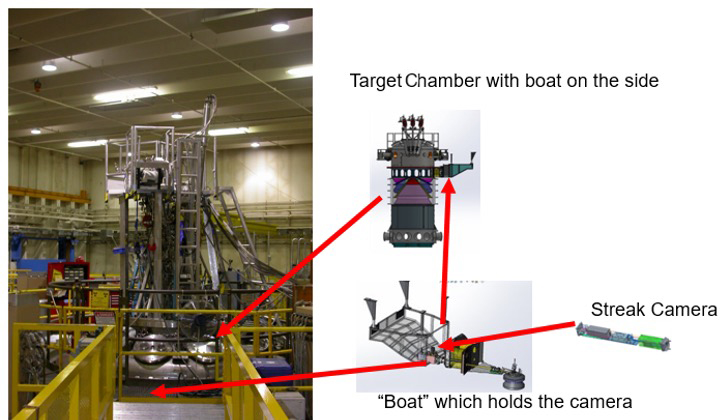 Streak camera radial implementation at Sandia National Laboratories’ Z machine will be used for laser performance verification experiments.
Streak camera radial implementation at Sandia National Laboratories’ Z machine will be used for laser performance verification experiments. Several engineering challenges need to be addressed when developing diagnostics for Z. They include extreme shocks of over 20 Gs that are experienced on every experiment; multi-million-electron-volt (MeV) x-ray backgrounds; and sensitive diagnostic components placed just above the pulsed-power components, requiring protection from electromagnetic impulses. In addition, high-energy debris (able to penetrate 15 centimeters of stainless steel at 2 meters) ejected from the target region can impact and damage sensitive diagnostic components.
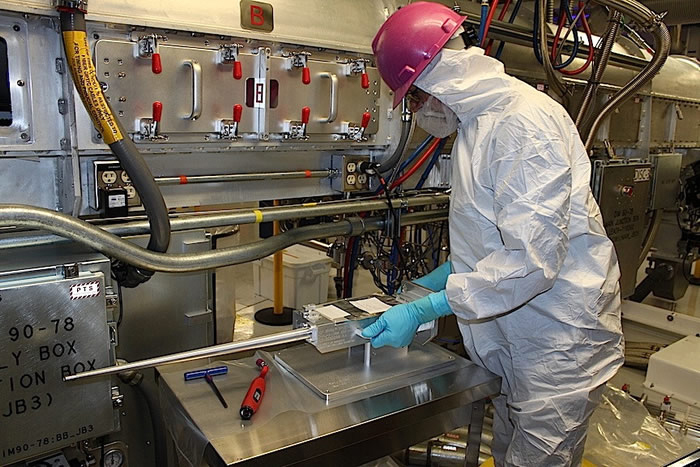 NIF Target Area operator Chris Saabye installs the NXS x-ray spectrometer snout on a DIM insertable streak camera (DISC) for an x-ray source development experiment.
NIF Target Area operator Chris Saabye installs the NXS x-ray spectrometer snout on a DIM insertable streak camera (DISC) for an x-ray source development experiment. One of the latest collaborations is bringing key stagnation diagnostics to Z, such as the x-ray streak camera and nTOF system.
“There are well-established diagnostic capabilities demonstrated at NIF that are used to make quantitative measurements on inertial confinement fusion (ICF) plasmas,” said Michael Jones, chief diagnostic scientist at Sandia. “With these demonstrated capabilities, it is transformational to bring the measurement to maturity for characterizing magnetic direct drive fusion plasmas on Z up to the long-standing ability of NIF. These diagnostic systems are key in addressing measurement gaps in both ICF and Assessment Science mission space.”
Keith LeChien, program group leader for Magnetic High-Energy Density Physics in LLNL’s Weapons and Complex Integration (WCI) organization, said WCI has been transferring diagnostics to Z for more than 10 years. He said WCI has been doing experiments at Z for 20 years and conducts roughly one-third of all ICF experiments conducted at the Z Facility.
“The diagnostics under development as part of the technology transfer effort will transform our understanding of high-pressure plasmas on the Z Facility,” LeChien said, “and are important in determining the requirements for ignition and high yield on a future pulsed power driver.”
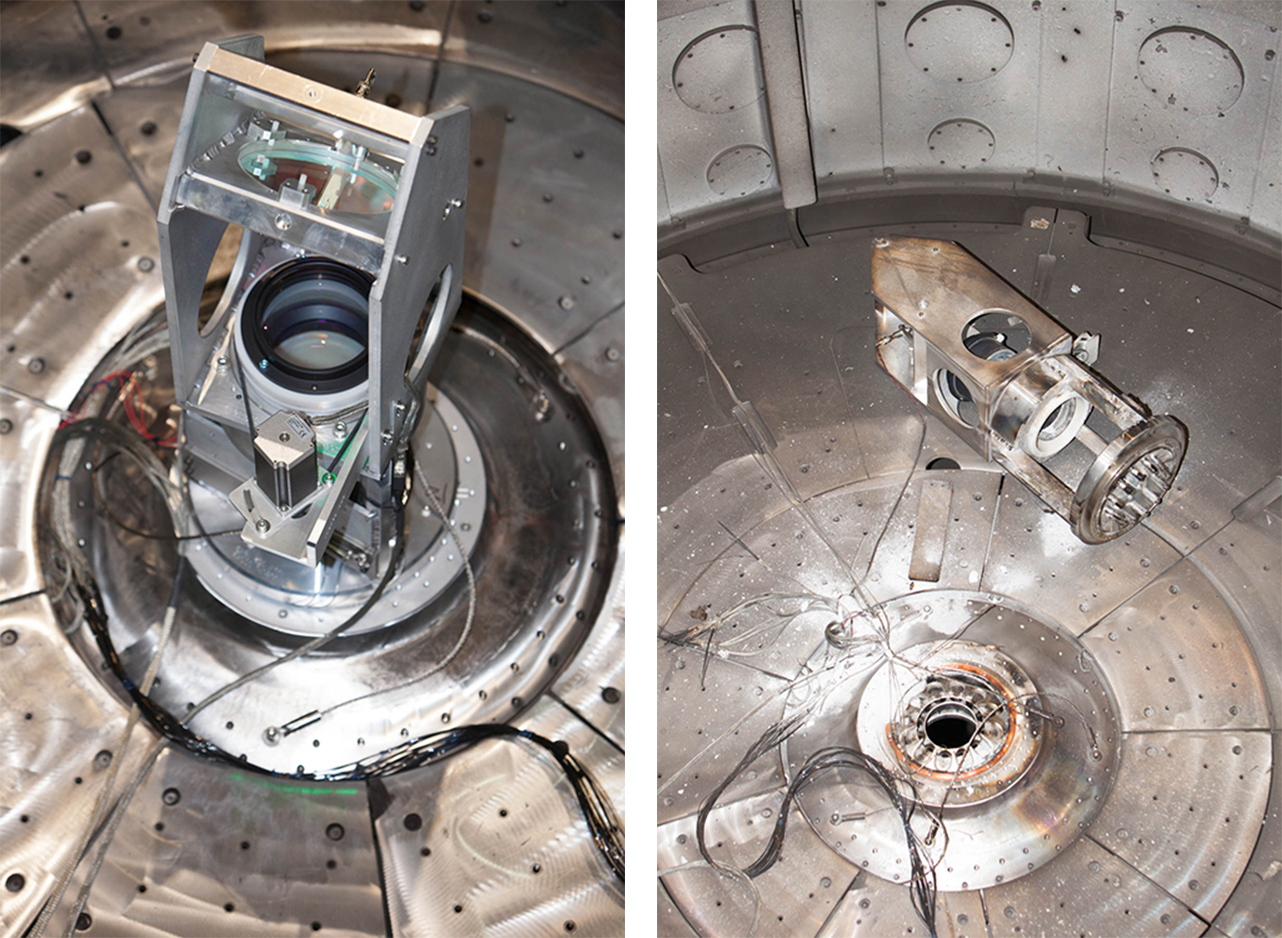 The Z line VISAR final optics assembly, which is destroyed in the shot. The images show the before (left) and after (right) of a Z shot. Credit: Michael Jones/Sandia National Laboratories.
The Z line VISAR final optics assembly, which is destroyed in the shot. The images show the before (left) and after (right) of a Z shot. Credit: Michael Jones/Sandia National Laboratories. Transferring Technology
The x-ray streak camera is used for laser performance verification experiments as well as a wide range of physics experiments in the areas of HED science, ICF, and basic science. The system was designed to record time-dependent x-ray emissions from NIF targets using an interchangeable family of “snouts” (enclosures at the end of diagnostic instrument manipulators, or DIMs, that hold the instruments in place in the Target Chamber) for measurements such as one-dimensional spatial imaging or spectroscopy.
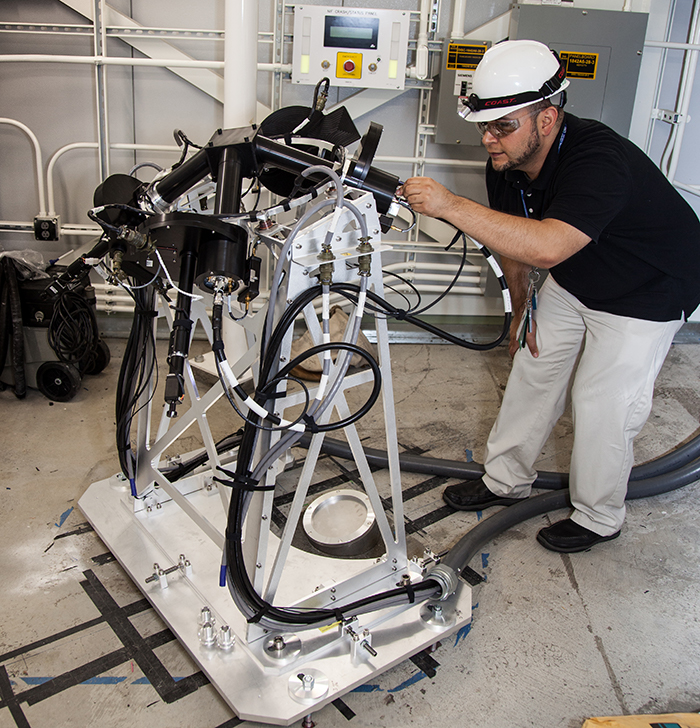 Target diagnostics engineer Francisco Barbosa services the north pole neutron time-of-flight detector (nTOF) on the roof of the NIF building. The diagnostic detects and records neutron arrival times during NIF experiments. Credit: James Pryatel.
Target diagnostics engineer Francisco Barbosa services the north pole neutron time-of-flight detector (nTOF) on the roof of the NIF building. The diagnostic detects and records neutron arrival times during NIF experiments. Credit: James Pryatel. At Z, the camera will be similar to NIF’s SPIDER (streaked polar instrumentation for diagnosing energetic radiation) for phase 1, enabling fast x-ray burn history measurement. Phase 2 will provide 1D streaked imaging, and phase 3 will focus on streaked spectroscopy.
“Understanding stagnation conditions is greatly enhanced through an analysis based on both x-ray and nuclear signatures,” Jones said. “One gap in the x-ray diagnostic suite at the Z facility is the lack of x-ray streak camera-based instruments. At NIF, x-ray streak cameras are regularly used to provide high temporal resolution x-ray burn history measurements (SPIDER), high temporal resolution 1D images of implosions (DISC, or the DIM insertable streak camera), and high temporal- and spatial-resolution spectroscopy measurements (DISC/tConSpec).”
The nTOF system measures the time-of-flight of neutrons emitted from the target. The arrival time at the detector provides the neutron energy, and the spread of arrival times is related to the ion temperature.
Jones discussed the improved nTOF for reliable ion temperature and kinetic energy: During the latter stages of the National Ignition Campaign (NIC) on NIF, it became clear that a significant amount of residual kinetic energy (RKE) was present during the burn phase of the implosion. This RKE manifested itself in significantly shifted and broadened neutron time-of-flight signals.
Quantifying the RKE requires measuring the nTOF signals along multiple independent lines of sight to fully disambiguate coherent and incoherent flow, as well as the true burn-weighted ion temperature.
The NIS uses a precisely aligned set of apertures near the target to capture neutron images on a segmented scintillator. The images are recorded on a gated, intensified charge-coupled device. Although the aperture set may be as close as 20 centimeters to the target, the imaging camera system is placed at a distance of 28 meters from the target.
 Before and after photos of an x-ray diffraction experiment on Z. Several megajoules of electrical energy is dissipated into several kilograms of mass at a small radius. This dissipated energy results in the target region being disassembled by shrapnel being ejected at high velocities, impacting diagnostics.
Before and after photos of an x-ray diffraction experiment on Z. Several megajoules of electrical energy is dissipated into several kilograms of mass at a small radius. This dissipated energy results in the target region being disassembled by shrapnel being ejected at high velocities, impacting diagnostics. 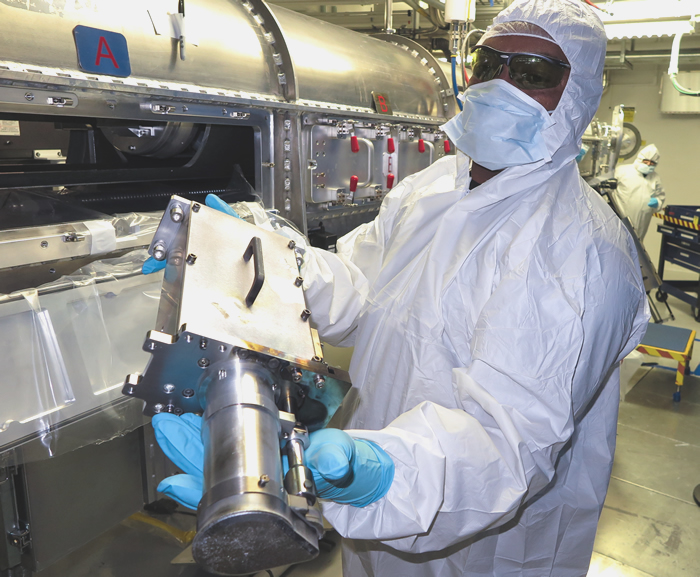 Target Area operator Bill Board removes the neutron imager snout from a diagnostic instrument manipulator. The NIF neutron imager system produces a two-dimensional image of the source distribution of the primary (14 million electron volt, or 14 MeV) neutrons and the “downscattered” neutrons, with energies in the range of 10 to 12 MeV, produced by fusion reactions in an imploding ICF capsule. Credit: James Pryatel
Target Area operator Bill Board removes the neutron imager snout from a diagnostic instrument manipulator. The NIF neutron imager system produces a two-dimensional image of the source distribution of the primary (14 million electron volt, or 14 MeV) neutrons and the “downscattered” neutrons, with energies in the range of 10 to 12 MeV, produced by fusion reactions in an imploding ICF capsule. Credit: James Pryatel During NIC, Sandia led the development of three diagnostic capabilities for NIF: SPIDER, RAGS (radiochemical analysis of gaseous samples), and NAD (nuclear reaction detector)20. Through the National Diagnostic Working Group, other transformational diagnostic capabilities have been developed for each lab. The two labs worked to bring a Wolter imaging diagnostic to Z, and Sandia continues to provide hCMOS (complementary metal oxide semiconductor) sensors that are used in several NIF diagnostics, including the groundbreaking Icarus camera system that enables researchers to capture a sequence of images that reveal hohlraum interactions during an ignition implosion with unprecedented resolution.
Another notable partnership between LLNL and Sandia was the line velocity interferometer system for any reflector (line VISAR) project that began in 2015 and was commissioned in 2018, when the technology was transferred to the Z Facility. This effort was awarded a National Nuclear Security Administration Defense Programs Award of Excellence.
According to Bowers, the strong relationship between LLNL and Sandia is required for these projects to work. LLNL experimentalists are learning how Z works and its constraints, while Sandia employees are learning about NIF, how to leverage NIF technology for Sandia, and what technologies are not amenable for transfer.
“Although COVID-19 has caused several issues with the collaboration, the positive side is that both teams work now by teleconferencing for all of the design work,” Bowers said. “Because of the new telecommuting mentality, the two teams have become integrated better. The Sandia and Livermore teams are working as one team.”
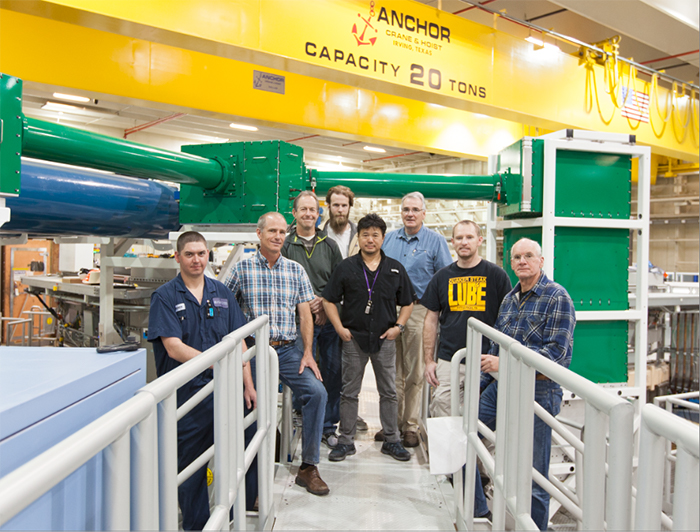 The Z Line VISAR team at the system’s November 2018 commissioning. Sandia team members include Keven MacRunnels, Dave Bliss, and Jacob Baker. LLNL team members include Gene Frieders, Gene Vergil de Dios, Neil Butler, Phil Datte, and Tom McCarville.
The Z Line VISAR team at the system’s November 2018 commissioning. Sandia team members include Keven MacRunnels, Dave Bliss, and Jacob Baker. LLNL team members include Gene Frieders, Gene Vergil de Dios, Neil Butler, Phil Datte, and Tom McCarville. —Michael Padilla
Follow us on Twitter: @lasers_llnl



